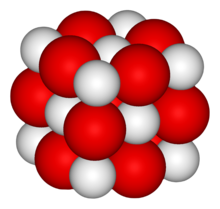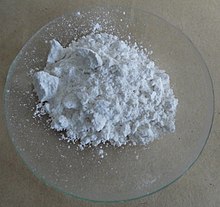
Calcium oxide
Chemical compound of calcium / From Wikipedia, the free encyclopedia
Dear Wikiwand AI, let's keep it short by simply answering these key questions:
Can you list the top facts and stats about Calcium oxide?
Summarize this article for a 10 year old
Calcium oxide (formula: CaO), commonly known as quicklime or burnt lime, is a widely used chemical compound. It is a white, caustic, alkaline, crystalline solid at room temperature. The broadly used term lime connotes calcium-containing inorganic compounds, in which carbonates, oxides, and hydroxides of calcium, silicon, magnesium, aluminium, and iron predominate. By contrast, quicklime specifically applies to the single compound calcium oxide. Calcium oxide that survives processing without reacting in building products, such as cement, is called free lime.[5]
 | |
 Powder sample of white calcium oxide | |
| Names | |
|---|---|
| IUPAC name
Calcium oxide | |
Other names
| |
| Identifiers | |
3D model (JSmol) |
|
| ChEBI | |
| ChEMBL | |
| ChemSpider | |
| ECHA InfoCard | 100.013.763 |
| EC Number |
|
| E number | E529 (acidity regulators, ...) |
| 485425 | |
| KEGG | |
PubChem CID |
|
| RTECS number |
|
| UNII | |
| UN number | 1910 |
CompTox Dashboard (EPA) |
|
| |
| |
| Properties | |
| CaO | |
| Molar mass | 56.0774 g/mol |
| Appearance | White to pale yellow/brown powder |
| Odor | Odorless |
| Density | 3.34 g/cm3[1] |
| Melting point | 2,613 °C (4,735 °F; 2,886 K)[1] |
| Boiling point | 2,850 °C (5,160 °F; 3,120 K) (100 hPa)[2] |
| Reacts to form calcium hydroxide | |
| Solubility in Methanol | Insoluble (also in diethyl ether, octanol) |
| Acidity (pKa) | 12.8 |
| −15.0×10−6 cm3/mol | |
| Structure | |
| Cubic, cF8 | |
| Thermochemistry | |
Std molar entropy (S⦵298) |
40 J·mol−1·K−1[3] |
Std enthalpy of formation (ΔfH⦵298) |
−635 kJ·mol−1[3] |
| Pharmacology | |
| QP53AX18 (WHO) | |
| Hazards | |
| GHS labelling: | |
  | |
| Danger | |
| H302, H314, H315, H335 | |
| P260, P261, P264, P270, P271, P280, P301+P312, P301+P330+P331, P302+P352, P303+P361+P353, P304+P340, P305+P351+P338, P310, P312, P321, P330, P332+P313, P362, P363, P403+P233, P405, P501 | |
| NFPA 704 (fire diamond) | |
| Flash point | Non-flammable[4] |
| NIOSH (US health exposure limits): | |
PEL (Permissible) |
TWA 5 mg/m3[4] |
REL (Recommended) |
TWA 2 mg/m3[4] |
IDLH (Immediate danger) |
25 mg/m3[4] |
| Safety data sheet (SDS) | ICSC 0409 |
| Related compounds | |
Other anions |
Calcium sulfide Calcium hydroxide Calcium selenide Calcium telluride |
Other cations |
Beryllium oxide Magnesium oxide Strontium oxide Barium oxide Radium oxide |
Except where otherwise noted, data are given for materials in their standard state (at 25 °C [77 °F], 100 kPa).
| |
Quicklime is relatively inexpensive. Both it and the chemical derivative calcium hydroxide (of which quicklime is the base anhydride) are important commodity chemicals.
